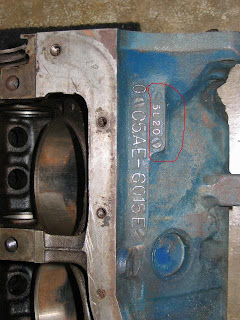





Ford used a few different formats of date coding the parts on a 65/66 Mustang. On sheet metal parts, such as fenders, hoods, shock towers, etc... there will be a number that goes like 4 12 2D. The first number is the month, with this one being, as you might suspect, April. The next number is the day of the month. The next one is the shift that stamped this particular part, in this case the second shift, and the letter indicates the plant that produced this particular part. The D is Dearborn, MI. C would be Cleveland, OH. W is Windsor, Ontario. There is nothing to indicate the year on the sheet metal parts. The picture is from the floor of my car underneath the back seat and this part was stamped on May 21st on the 3rd shift in Cleveland.
On cast iron parts, like cylinder heads, engine blocks, etc.. the format is different. They go like 4M13. The first number is the last digit of the year, the letter is the month and the next one or two digits are the day of the month. The picture of the engine block shows a date code of 5L20, which is november 20th of 65. The picture of the cylinder head shows a date code of 9A9, which is January 9th of 69. On the letter designations a lot of people 'miscount' because they didn't realize that Ford did not use the letter I (eye) because it looks too much like the number 1.
The aluminium parts, like bell housings, some water pumps, etc.. Had a system that is a little bit weird looking if you are unfamiliar with how it works, but is actually pretty simple. There will be a two digit number, indicating the year, inside a circle that has some bumps around the perimeter. On a really, really nice one, it looks like a pie sliced into 12 pieces, but most parts haven't withstood the march of time nearly well enough to be able to see that. On this picture of the starter hump on a five-bolt bell housing, you will see the number 64, indicating, as you might suspect, 1964, and 4 little bumps. That means April, so this bell housing was cast in April of 1964.
Nothing to it.
The date codes used for the scheduled production dates of cars was simply a two digit number, indicating day and a letter indicating month. There is sometimes a little bit of confusion surrounding the letter designations for the 65 model production year. The sheduled production date of the first Mustangs were in march of 64, so the letters A and B weren't used then. They started with C for march of 64, going C-H for march through august of 64, skipping the letter I and using the letter J for september and going J-M september through december, jumped back to the letter A for january of 65, B for february of 65 and picked back up with Q for march of 65, and went Q-V for march-august of 65.
The carburetor tag will have a date code stamped on it which will have 3 digits, one number followed by two letters. The number is the year, followed by the month and then the week of that month. The one in the picture says 6CC, which would be 1966, march, the third week of the month. Sometimes you will see the letter 'E' as the last digit on the tag, which is the fifth week of the month. If the first falls on a friday, production for that month would have fallen across five different weeks.
The distributor date code is in the same format as the cast iron parts, except for it is stamped into the housing, instead of cast in, like on an engine block or cylinder head or something.

No comments:
Post a Comment